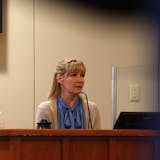Mayo Clinic is going public with a modeling approach to predicting COVID-19 trends that its leaders said has effectively guided their hospital preparations since the start of the pandemic.
The Rochester-based health system is unveiling an online tracking tool Thursday that provides recent COVID-19 case data for U.S. counties, as well as reputable advice on how to prevent infections with the coronavirus that causes the disease. The tool on the mayoclinic.org site will be updated this fall with county-level modeling forecasts for pandemic activity.
"There are a lot of websites — including the Johns Hopkins website, IHME, Google, CDC — and a lot of their predictions they're doing about cases and hospitalizations are at the state level," said Dr. Henry Ting, Mayo's chief value officer, who led the development of the tracker. "We thought there was a need for people to have information about cases … at the county level."
Modeling has been a key but controversial component of national and state responses to the pandemic. The University of Minnesota and the Minnesota Department of Health created models that forecast how changes such as business closures and other restrictions would reduce viral spread.
Gov. Tim Walz factored that trend data in his decision to enact a state shutdown for 51 days this spring, but received criticism from political opponents because the models overestimated COVID deaths.
State Health Commissioner Jan Malcolm said on Wednesday that she couldn't disclose specifics, but that U researchers had revised methodology for a new round of predictive modeling on COVID-19 trends.
"It's being worked on ... with some different updates to the model, different improvements to parameters and assumptions based on more Minnesota data," she said.
IHME, or the Institute for Health Metrics and Evaluation, in Washington state, has been predicting death tolls since the start of the pandemic based partly on states' response strategies to slow the spread of the virus. It currently predicts a total of 4,990 COVID-19 deaths in Minnesota by year's end, but only 2,372 deaths if the state maintains a universal mask mandate and 95% of residents follow it.



